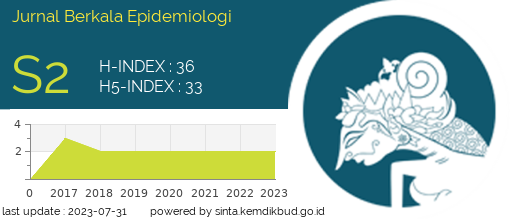System Analysis of Dengue Virus Surveillance in BBTKL PP Surabaya Year 2012–2014
Downloads
Changes in the distribution of dengue virus serotypes have occurred in Indonesia. These changes must be monitored continuously through laboratory-based epidemiological surveillance of dengue viruses, one of which is carried out by the Center of Environmental Health and Disease Control Agency (BBTKLPP) Surabaya. The purpose of this study is to determine the workflow, identify problems, determine priority problems, find the cause of the problem, and provide alternative solutions related to problems in the implementation of molecular epidemiological surveillance of dengue viruses that have been carried out by BBTKLPP Surabaya. This research is a descriptive study with informants is molecular epidemiological surveillance officers of the dengue virus in BBTKLPP Surabaya. Data processing and analysis are done descriptively and presented in narrative form. The results showed that the molecular epidemiological surveillance workflow of the dengue virus in BBTKLPP Surabaya consisted of collecting blood specimens from patients and vectors, vector surveys and supporting data collection, rapid diagnostic test examinations, and polymerase chain reaction, data processing and analysis and information dissemination. The main problem in implementing this surveillance is the quality of the information generated is still low. The problem tree analysis results show that the cause of the problem that can be intervened is incomplete supporting data and data not collected in one storage medium. An alternative solution to overcome this problem is through the use of a database management system is Epi-info.
Balai Besar Teknik Kesehatan Lingkungan dan Pengendalian Penyakit (BBTKL PP) Surabaya. 2012. Pedoman Operasional Kerja: Surveilans Epidemiologi Molekuler Virus Dengue. Surabaya: BBTKL PP Surabaya.
Candra, A. 2010. Demam Berdarah Dengue: Epidemiologi, Patologi, dan Faktor Risiko Penularan. Aspirator Vol.2 No.2 Hal: 110–119.
Great Lakes Epidemiology Center, Community Based Research Training. 2004. Epi Info Beginner's manual with Exercises. http://inclentrust.org/ inclen/uploadedbyfck/file/3%20Research%20 Tools_Instruments_Softwares/Stat%20Sofwares/ Epi_Info_Beginners_Manual.pdf [diakses pada tanggal 28 Maret 2015 pukul 19:41].
Guerdan, BR. 2010. Dengue Fever/Dengue Hemorrhagic Fever. American Journal of Clinical Medicine Vol: 7 No: 2 Hal: 51–52.
Hanim, D, Putranto, W, Sidik, HP, Hapsari, S. 2013. Program Pengendalian Penyakit Menular: Demam Berdarah Dengue. Surakarta: Fakultas Kedokteran Universitas Negeri Surakarta. Hal: 5–18.
Jacky, MJ 2009. Identifying Challenges to the Integration of Computer-Based Surveillance Information Systems in a Large City Health Department: A Case Study. Public Health Reports Vol: 124 No: 2 Hal: 40–47.
Kate, B. 2013. Health and Environmental Data in the Great Lakes Basin - Integrating Data Collection and Analysis. Laporan kepada International Joint Commission oleh Health Professionals Advisory Board.
Kementerian Kesehatan RI. 2009. Modul 5 Aplikasi Pengolah Data Surveilans. Jakarta: Kementerian Kesehatan RI.
Kementerian Kesehatan RI. 2010. Demam Berdarah Dengue di Indonesia Tahun 1968–2009. Buletin Jendela Epidemiologi Vol: 2 Hal: 1–6.
Kementerian Kesehatan RI. 2015. Kebijakan Program Pengendalian Penyakit Bersumber Binatang, Direktorat Jenderal PP dan PL. Disampaikan dalam pertemuan jejaring di Lawang, Malang pada tanggal 11–14 Februari 2015.
Knudsen, E. 2012. Epi InfoTM 7 Quick Start G u i d e . h t t p s : / / d o c s . g o o g l e . c o m / f i l e / d/0B1mGcf7b92K6R2dSQm54UTZHQ1U/ edit?pli=1 [diakses pada tanggal 28 Maret 2015 pukul 17:56].
Kusrini. 2007. Strategi Perancangan dan Pengelolaan Basis Data. Yogyakarta: ANDI.
Lailiyah, S. 2010. Pengembangan Basis Data Surveilans Epidemiologi Demam Berdarah Dengue (DBD) di Dinas Kesehatan Kabupaten Trenggalek. Tesis. Program Pasca Sarjana. Universitas Airlangga: Surabaya.
Mir, R. 2014. Epi Info TM 7 and Data Integration: CDC Global Health Security (GHS) Demo Project (2013) in Uganda. Disampaikan dalam Public Health Informatics Conference pada 30 April 2014.
Mustafa, MS, Rasotgi, V, Jain, S, Gupta, V.l. 2014. Discovery of Fifth Serotype of Dengue Virus (DENV-5): A New Public Health Dilemma in Dengue Control. Medical Journal Armed Forces India Vol: 7 No: 1 Hal: 67–70.
Ooi, EE dan Gubler, DJ. 2008. Dengue in Southeast Asia: Epidemiological Characteristics and Strategic Challenges in Disease Prevention. Artigo Vol: 25 No: 1 Hal:115–124.
Sitepu, FY dan Supriyadi, T. 2013. Evaluasi Program Pengendalian dan Pencegahan Demam Berdarah Dengue (DBD) di Sumatera Utara Tahun 2010–2012. BALABA Vol: 9 No: 1 Hal: 1.
Supriyatni, N. 2009. Pengembangan Basisdata Pelacakan Kasus Difteri di Dinas Kesehatan Provinsi Jawa Timur. Tesis. Program Pasca Sarjana. Universitas Airlangga: Surabaya.
Sutanta, Edhy. 2004. Sistem Basis Data. Yogyakarta: Graha Ilmu.
U.S. Agency for International Development (USAID). 2005. Epi Info Guide: Data Management and Analysis. www.cpc.unc.edu/Epi%20Info%20 Guide.pdf [diakses pada tanggal 28 Maret 2015 pukul 18:08].
World Health Organization (WHO). 2012. Global Strategy for Dengue Prevention and Control (2012–2020). WHO Press. Hal: 5–12.
World Health Organization. (2009). Instructions for Data-Entry and Data-Analysis Using Epi Info TM. www.who.int/gpsc/5may/epi_info_instructions. pdf [diakses pada tanggal 28 Maret 2015 pukul 19:41].
World Health Organization. 2013a. Evaluating A National Surveillance System. World Health Organization: Geneva.
World Health Organization. 2013b. Integrated Surveillance of Antimicrobial Resistance. World Health Organization: Geneva.
- Every manuscript submitted to must observe the policy and terms set by the Jurnal Berkala Epidemiologi
- Publication rights to manuscript content published by the Jurnal Berkala Epidemiologi is owned by the journal with the consent and approval of the author(s) concerned. (download copyright agreement)
- Complete texts of electronically published manuscripts can be accessed free of charge if used for educational and research purposes according to copyright regulations.

JBE by Universitas Airlangga is licensed under a Creative Commons Attribution-ShareAlike 4.0 International License.























